Heitjans P., Karger J. (Eds.). Diffusion in Condensed Matter: Methods, Materials, Models
Подождите немного. Документ загружается.


600 Alfred Leipertz and Andreas P. Fr¨oba
15.4.2 Mutual Diffusion Coefficient
The problems encountered in measuring the mutual diffusion coefficient D
12
are of a similar nature as those of measuring the thermal diffusivity of mix-
tures. In either case there are basically signals from both temperature and
concentration fluctuations. As the mutual diffusion coefficient is in general
at least one order of magnitude smaller than the thermal diffusivity, larger
angles may be chosen for the determination of this property. It is especially
interesting, however, to perform the measurements with an identical setup
as for a, as both properties may then be measured simultaneously. Whether
one succeeds, is again governed by the actual separation of decay times and
by the ratio of the signals.
As an example, the thermal diffusivity and the mutual diffusion coefficient
of the binary system acetone and carbontetrachloride with a difference in the
refractive indices of 7.4% are shown in Fig. 15.13, where the situation is
favourable, as the signals are of the same order of magnitude [32].
In most instances, especially when the difference of refractive indices
is large, the determination of the mutual diffusion coefficient may be per-
formed by standard experiments. Fig. 15.14 shows the measured tempera-
ture dependence of the mutual diffusion coefficient of the separation system
n-hexane/nitrobenzene [33]. According to the stability theory of thermody-
namics, D
12
disappears at the critical separation point (temperature T
c
),
which can be clearly seen from Fig. 15.14. This effect of vanishing diffusiv-
ities on approaching the critical point is generally referred to as “critical
slowing down”. Further details about the theory of mutual diffusion includ-
ing the phenomenon of the critical slowing down may be found in Chaps. 3
14, and 16 (Fig. 16.29).
Fig. 15.13. Thermal diffusivity and mutual diffusion coefficient of the mixture
acetone/carbon tetrachloride as a function of composition [32].
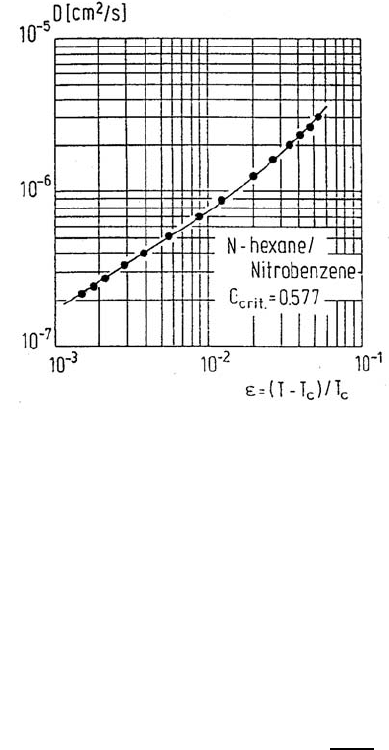
15 Diffusion Measurements in Fluids by Dynamic Light Scattering 601
Fig. 15.14. Mutual diffusion coefficient of a separation system as a function of the
reduced temperature =(T − T
c
)/T
c
[33].
15.4.3 Dynamic Viscosity
The determination of the dynamic viscosity η of liquids is in some way differ-
ent from the measurement of the other properties treated so far, as it requires
the addition of seed particles. The quantity which is actually measured is the
(translational) particle diffusion coefficient D
P
of spherical particles, which
results in another Rayleigh peak in the spectrum. The particle diffusion co-
efficient is related via the Stokes-Einstein equation [34,35]
D
P
=
k
B
T
3πηd
(15.31)
with viscosity η, particle diameter d, Boltzmann constant k
B
and tempera-
ture T . In the low-concentration range (i.e. under the assumption that there
is no particle-particle interaction as implied in fact for deriving (15.31)) this
diffusivity is clearly nothing else than the particle self-diffusivity (cf., e.g.,
Chaps. 10, 14, and 16). Two possible fields of applications are contained in
this relation. One area of research is the determination of particle size dis-
tributions and, as macromolecules may be regarded as special particles, the
determination of molecular weight [36,37]. As with a distribution of particle
sizes a distribution of particle diffusion coefficients results, the ACF is a su-
perposition of exponentials with various decay times. The major problem in
this field is then to recover the size distribution from the experimental ACF,
which is a difficult and, with experimental noise given, sometimes impossi-
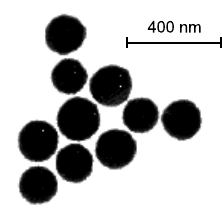
602 Alfred Leipertz and Andreas P. Fr¨oba
Fig. 15.15. Electron microscope picture of silica particles, courtesy: A.P. Philipse,
University of Utrecht.
ble task, as different size distributions may result in very similar correlation
functions. Here, the other application related with particle diffusion coeffi-
cients shall be given some more consideration, namely the determination of
the dynamic viscosity [38–40].
Generally, as D
P
is orders of magnitude smaller than the other diffu-
sion coefficients in the Rayleigh-Brillouin spectrum, this quantity is normally
probed at large scattering angles. Another difference is that for the determi-
nation of the viscosity the usage of low-power lasers such as He-Ne or diode
lasers is sufficient in most cases, as the scattering cross section of the parti-
cles is usually much larger than that of other fluctuations in the fluid itself.
Accordingly, a homodyne detection scheme is normally employed, and the
measurements are not affected by other components in the spectrum.
A key to a successful determination of the viscosity is the choice of suit-
able particles in a size range of some 20 nm to 500 nm. These are to be
spherical and monodisperse, or at least are to exhibit a narrow size distribu-
tion, in order to ensure a correlation function which matches the model of a
pure exponential, which is essential for a reliable data evaluation. Moreover,
they must be chemically stable and form stable dispersions. There have been
a number of investigations with different seed particles, but it has turned out
that silica particles with various surface modifications are most appropriate
for a wide range of liquids (see Fig. 15.15). Particle sizes are best calibrated
by DLS measurements in liquids with known viscosities. For high-accuracy
measurements the governing conditions of the working model must be met
what means in this case unhindered particle diffusion and no multiple scatter-
ing in the sample. For these reasons it is essential to use low particle volume
fractions of typically 10
−4
and to vary the particle concentration and/or scat-
tering angle. In connection with a careful inspection of the ACF this approach
ensures reliable results. An experimental result is shown in Fig. 15.16, where
the viscosity of n-heptane was measured to check the technique. This liquid
was chosen, because there are reliable reference data [41] both for n-heptane
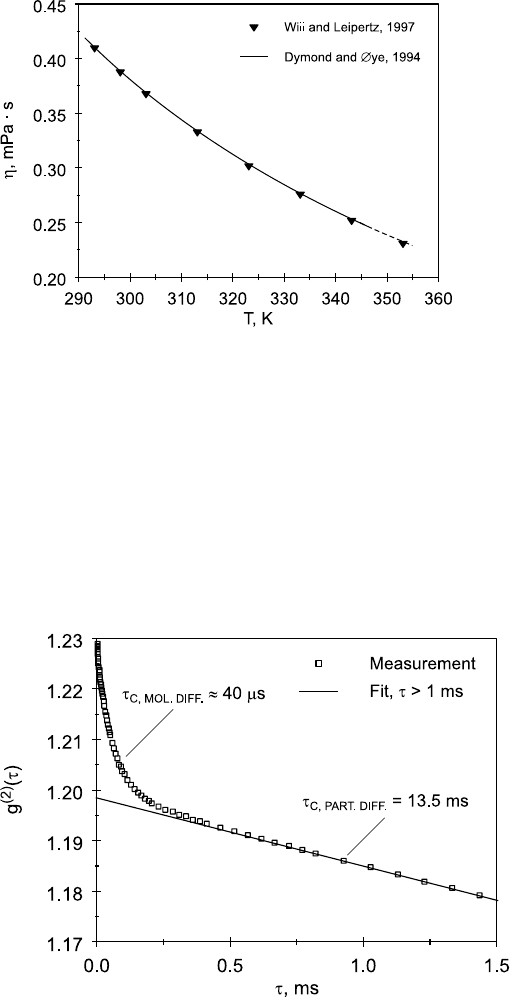
15 Diffusion Measurements in Fluids by Dynamic Light Scattering 603
Fig. 15.16. Viscosity of liquid n-heptane [40] in comparison with reference data
[41].
itself and for n-hexane and n-octane, which were used for calibrating the
particle size at room temperature.
As the numerical value of the mutual diffusion coefficient is in between
those of the thermal diffusivity and the particle diffusion coefficient, prospects
open of a simultaneous measurement of η and D
12
. In Fig. 15.17 a correlation
function is plotted, which was measured in a paraffin oil, a mixture of many
hydrocarbons of chain lengths ranging from about 15−40 carbon atoms. Per-
Fig. 15.17. Experimental ACF of a paraffin oil with seed particles added. The
signals from particle and molecular diffusion may be clearly separated [42].
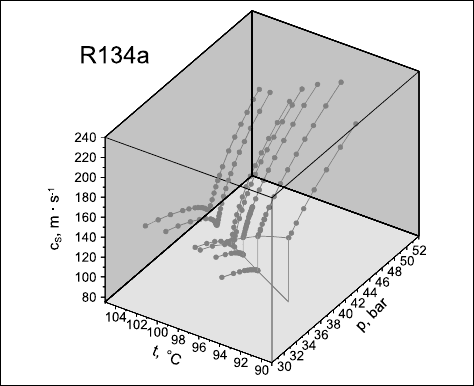
604 Alfred Leipertz and Andreas P. Fr¨oba
forming a fit for times larger than 1 ms the ACF can be very well represented
by a single exponential with a decay time of 13.5 ms. Additionally, there is
another signal at small decay times, which is due to molecular diffusion and,
due to the nature of this multi-component mixture, is built up of several
individual diffusion signals.
15.4.4 Sound Velocity and Sound Attenuation
For the measurement of sound velocity c
S
and sound attenuation D
S
the
Brillouin components of the spectrum are investigated. As the Brillouin lines
are shifted in frequency, a heterodyne technique with a local oscillator, which
is also shifted in frequency by means of an acousto-optic modulator, is used
[3]. This results in a correlation function in form of a damped oscillation,
(15.26), where the sound attenuation is determined from the decay-time τ
C
as usual and the sound velocity is deduced from the known frequency shift
by the modulator ω
M
and the residual mistuning ∆ω of the correlogram.
The simplest way of determining ∆ω is by applying a Fourier transform to
the measured correlation function, where the frequency is found from the
maximum of the resulting spectrum [43]. Dynamic light scattering can be
used to measure the sound velocity with an uncertainty of about 0.5%. This
technique has again been often applied to various refrigerants [29, 44]. An
example is depicted in Fig. 15.18.
In determining the sound attenuation one has to face two problems. One
is that due to the large width of the Brillouin lines the decay-time of the
Fig. 15.18. Sound velocity of refrigerant R134a in a wide range around the critical
point [46].
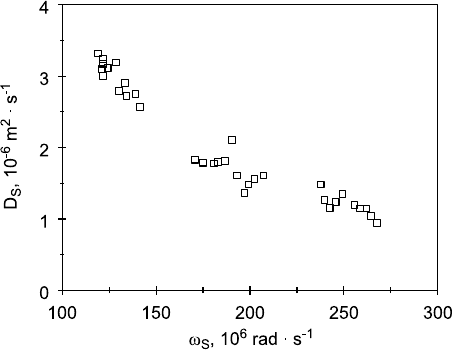
15 Diffusion Measurements in Fluids by Dynamic Light Scattering 605
Fig. 15.19. Frequency dispersion with the measurement of sound attenuation;
sample: refrigerant R125, saturated liquid at 45
◦
C [44].
correlation function is typically only a few hundreds of nanoseconds, even if
small scattering angles are employed, which requires the use of fast correla-
tors. The other problem is of a more fundamental nature and is caused by a
lack of definition of the scattering vector [3, 44]. Due to the finite width of
stops in the detection optics there is always some angular spread, which is a
combination of a simple geometrical and a diffraction effect. This uncertainty
does not have a significant effect on probing the Rayleigh line, but causes a
spread in the position of the Brillouin line. Thus, the linewidth probed in a
spectroscopic experiment is a convolution of the distribution of positions and
the actual linewidth. Analyzing the scattered light in the time-domain one
obtains in the presence of this effect a decay time being shorter than asso-
ciated with the sound attenuation. However, one has to realize experimental
conditions, where the angular uncertainty is as small as possible. This may
be realized by placing the stops in the detection optics as far as 4 −6 m apart
from each other.
These difficulties result in a reduced accuracy of measuring D
S
of about
10%, which still is better than by direct spectroscopic methods. Finally, it
must be pointed out that all measurements of sound velocity and attenuation
are basically dependent on the actual frequency used in the experiment. This
dispersion effect has turned out to be negligible for many fluids and the
frequencies probed by DLS as the sound velocity is considered, but is marked
for the sound attenuation, especially of refrigerants, cf. Fig. 15.19.
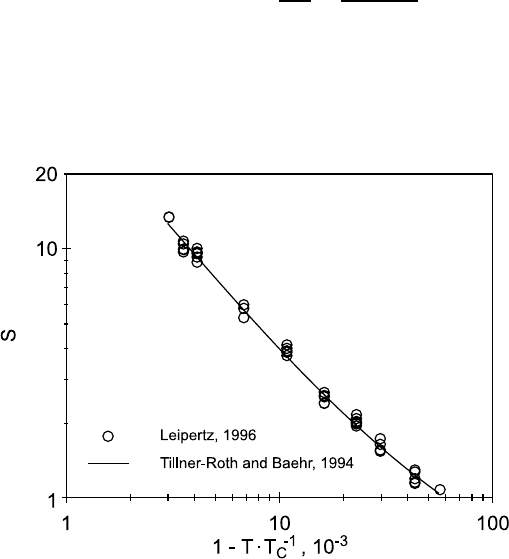
606 Alfred Leipertz and Andreas P. Fr¨oba
15.4.5 Landau-Placzek Ratio
The Landau-Placzek ratio S is defined as the ratio of intensities of the
Rayleigh to Brillouin lines and is related to the specific heats c
p
and c
v
by
S =
I
R
2I
B
=
(c
p
− c
v
)
c
v
. (15.32)
The Landau-Placzek ratio may be obtained from the evaluation of the con-
trasts in various heterodyne experiments, when a local oscillator with defined
intensity is added [45]. An example of such measurements is provided by
Fig. 15.20.
Fig. 15.20. Landau-Placzek ratio for refrigerant R134a obtained by DLS measure-
ments [47] in comparison with reference data from the equation of state [48].
15.4.6 Soret Coefficient
When a binary liquid mixture is brought into a temperature gradient ∇T ,
mass diffusion occurs resulting in a concentration gradient ∇c.ThisSoret
effect may be described by the relation
∇c = −S
T
c(1 − c) ∇T, (15.33)
where S
T
is the Soret coefficient and c is the mass fraction of the heavier
component. When DLS experiments are carried out in a steady temperature

15 Diffusion Measurements in Fluids by Dynamic Light Scattering 607
gradient, the Soret coefficient may be derived from the amplitude of the con-
centration mode in the resulting correlation function [49]. As this amplitude
is proportional to (∇T )
2
/q
4
very small scattering angles of order 1
◦
must be
employed, where the scattering angle can hardly be measured exactly, but
may be calibrated by a DLS measurement in a system where the diffusion
coefficient is known.
15.4.7 Derivable Properties
Dynamic light scattering is a technique which allows the measurement of a
large variety of thermophysical properties, in some instances even within a
single experiment. Besides the data, which can be measured directly, more
properties may be derived in connection of DLS data with additional infor-
mation from other techniques. A few examples will be given here.
Whereas the Landau-Placzek ratio relating isobaric and isochoric specific
heat capacities, (15.32), may be directly derived from DLS experiments, there
is no straightforward access to either of these values. In order to obtain in-
formation on c
p
, it is therefore necessary to combine data from DLS with
other properties from different measurement techniques. As DLS can probe
the thermal diffusivity very successfully, the combination with data for the
thermal conductivity λ, which can be measured by various techniques di-
rectly, and for the fluid density ρ, which can be determined very accurately,
yields information on c
p
according to c
p
= λ/(aρ). An example for this proce-
dure including a comparison with values obtained from an equation of state
is given by Fr¨oba et al. [50]. Using c
p
and S, the isochoric heat results as
c
v
= c
p
/(S + 1) which immediately follows from (15.32).
The isentropic compressibility χ
s
=1/(ρc
2
S
) follows directly from density
ρ and the sound velocity c
S
measured by DLS. Accordingly, the isentropic
exponent κ = ρc
2
S
/p may be derived with the knowledge of the equation of
state of the fluid. The sound attenuation D
S
is related to a number of other
thermophysical properties via
D
S
=
(4/3)η
s
+ η
v
+(1/c
v
− 1/c
p
)λ
2ρ
. (15.34)
In this notation, the usual dynamic viscosity has been given an index s to
emphasize that this is the shear viscosity in contrast to the bulk viscos-
ity η
v
.WithameasurementofD
S
and knowledge of the other quantities,
which again may mostly be derived from DLS measurements, information on
the bulk viscosity may be deduced, which is an important property for the
description of structural relaxation and which is not readily obtainable by
experiment.
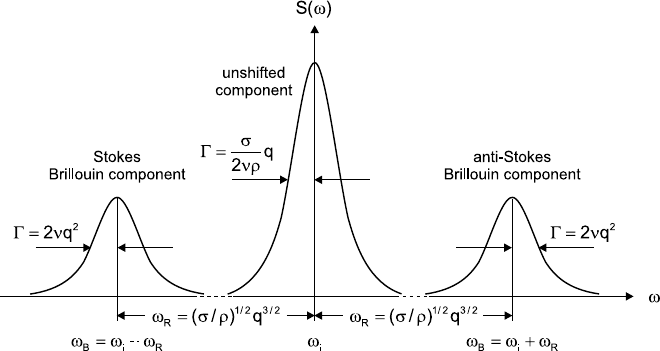
608 Alfred Leipertz and Andreas P. Fr¨oba
15.5 Related Techniques
15.5.1 Surface Light Scattering
Surface light scattering (SLS) is a technique which is closely related to dy-
namic light scattering in its classical meaning. The difference is that this
technique probes, as the name indicates, fluctuations on the surface of a liq-
uid or, in a more general formulation, at phase boundaries. These fluctuations
can be understood as thermally excited capillary waves of small amplitude
(∼ 1 −100 nm) and with a characteristic wavelength (∼ 0.1 −1000 µm) and
that are quantized in so-called “ripplons” [51].
In general, for the temporal decay of surface fluctuations two cases may be
distinguished. In the case of large viscosity and/or small surface tension, the
amplitude of surface waves is damped exponentially, while in the case of small
viscosity and/or large surface tension the amplitude decays in the form of a
damped oscillation. Light interacting with such a fluctuating surface structure
is scattered. An exponential decay of surface waves results solely in a spectral
broadening of the light spectrum, whereas an oscillatory damping gives rise
to a Brillouin doublet [52]. Hence, the spectrum exhibits three characteristic
lines, qualitatively similar to that from light scattered in a bulk fluid, where
line widths and separation are related to the modulus q of the scattering
vector, kinematic viscosity ν, surface tension σ, and density ρ as shown in
Fig. 15.21 in a first order approximation. A Lorentzian shape of these lines as
well as the relations for line widths and separation as indicated in Fig. 15.21
only hold in the limiting cases y 0.145 or y 0.145, respectively, with
Fig. 15.21. Spectrum of scattered light by surface waves: frequency unshifted line
(center) in the case of large viscosity and/or small surface tension; frequency shifted
Brillouin lines in the case of small viscosity and/or large surface tension.

15 Diffusion Measurements in Fluids by Dynamic Light Scattering 609
y = σρ/(4η
2
q). For y values close to 0.145 the line shapes become more
complex [51,53].
In practice, also the spectrum of light scattered by the fluctuations at a
liquid surface can only be resolved in a post-detection filtering scheme us-
ing, e.g., photon correlation spectroscopy (PCS). For heterodyne conditions,
where the scattered light is superimposed with stronger coherent reference
light, the normalized time-dependent intensity correlation function for the
analysis of surface fluctuations is described by
g
(2)
(τ)=a + b cos (ω
R
τ)exp(−τ/τ
C
). (15.35)
or
g
(2)
(τ)=a + b exp (−τ/τ
C
). (15.36)
assuming the decay of the amplitude of surface waves is oscillatory (y
0.145) or overdamped (y 0.145), respectively. Due to the usually small
frequency separation of the shifted Brillouin lines commonly no frequency
shift of the coherent reference light is necessary. In the propagating case
of surface fluctuations the correlation function (15.35) can be used for the
simultaneous evaluation of surface tension σ and kinematic viscosity ν.The
correlation time τ
C
and the frequency ω
R
, which are identical with the mean
life time of “ripplons” and the frequency of propagation, respectively, are
given in first order approximation by
τ
C
=
1
2νq
2
ω
R
=
σ
ρ
1/2
q
3/2
. (15.37)
In the overdamped case, if the fluid viscosity is large and/or the surface
tension is very small, the lifetime of “ripplons” in (15.36) is given in a first-
order approximation by
τ
C
=
2νρ
σq
. (15.38)
For a reliable determination of viscosity and surface tension a more detailed
and rigorous consideration of the surface light scattering method than given
by (15.35) to (15.38) has to be applied. Here, the reader is referred to litera-
ture, see, e.g., [54].
Although it has been shown that SLS may be performed in complete anal-
ogy to DLS measurements from bulk fluids using an identical set-up [50,55],
some differing design features are often employed for SLS measurements. One
obvious difference is that SLS normally investigates interfaces in horizontal
orientation within a sample cell with light impinging from above. Commonly,
scattered light is observed near the reflected beam [56], i.e. also in the top
direction, which eases the optical access and is of course essential for non-
transparent fluids. Alternatively, for transparent fluids scattered light may
be observed close to the direction of the refracted beam [57, 58], which is
advantageous due to stability considerations and scattering intensities. By
